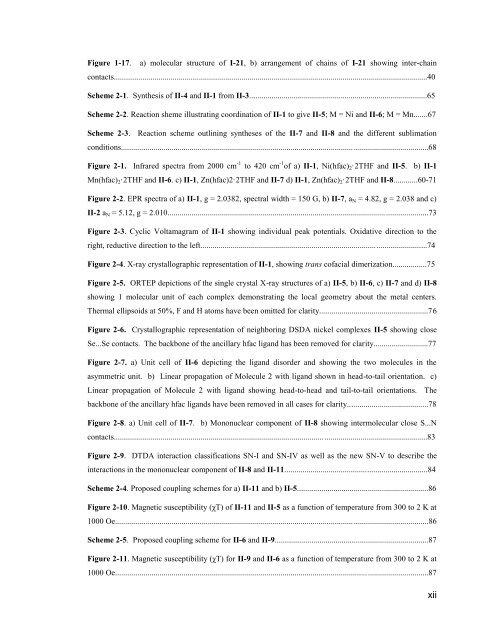1,2,3-Dithiazolyl and 1,2,35-Dithiadiazolyl Radicals as Spin-Bearing ...
1,2,3-Dithiazolyl and 1,2,35-Dithiadiazolyl Radicals as Spin-Bearing ...
1,2,3-Dithiazolyl and 1,2,35-Dithiadiazolyl Radicals as Spin-Bearing ...
Create successful ePaper yourself
Turn your PDF publications into a flip-book with our unique Google optimized e-Paper software.
Figure 1-17. a) molecular structure of I-21, b) arrangement of chains of I-21 showing inter-chain<br />
contacts...........................................................................................................................................................40<br />
Scheme 2-1. Synthesis of II-4 <strong>and</strong> II-1 from II-3........................................................................................65<br />
Scheme 2-2. Reaction sheme illustrating coordination of II-1 to give II-5; M = Ni <strong>and</strong> II-6; M = Mn.......67<br />
Scheme 2-3. Reaction scheme outlining syntheses of the II-7 <strong>and</strong> II-8 <strong>and</strong> the different sublimation<br />
conditions........................................................................................................................................................68<br />
Figure 2-1. Infrared spectra from 2000 cm -1 to 420 cm -1 of a) II-1, Ni(hfac) 2·2THF <strong>and</strong> II-5. b) II-1<br />
Mn(hfac) 2·2THF <strong>and</strong> II-6. c) II-1, Zn(hfac)2·2THF <strong>and</strong> II-7 d) II-1, Zn(hfac) 2·2THF <strong>and</strong> II-8............60-71<br />
Figure 2-2. EPR spectra of a) II-1, g = 2.0382, spectral width = 150 G, b) II-7, a N = 4.82, g = 2.038 <strong>and</strong> c)<br />
II-2 a N = 5.12, g = 2.010.................................................................................................................................73<br />
Figure 2-3. Cyclic Voltamagram of II-1 showing individual peak potentials. Oxidative direction to the<br />
right, reductive direction to the left................................................................................................................74<br />
Figure 2-4. X-ray crystallographic representation of II-1, showing trans cofacial dimerization.................75<br />
Figure 2-5. ORTEP depictions of the single crystal X-ray structures of a) II-5, b) II-6, c) II-7 <strong>and</strong> d) II-8<br />
showing 1 molecular unit of each complex demonstrating the local geometry about the metal centers.<br />
Thermal ellipsoids at 50%, F <strong>and</strong> H atoms have been omitted for clarity......................................................76<br />
Figure 2-6. Crystallographic representation of neighboring DSDA nickel complexes II-5 showing close<br />
Se...Se contacts. The backbone of the ancillary hfac lig<strong>and</strong> h<strong>as</strong> been removed for clarity...........................77<br />
Figure 2-7. a) Unit cell of II-6 depicting the lig<strong>and</strong> disorder <strong>and</strong> showing the two molecules in the<br />
<strong>as</strong>ymmetric unit. b) Linear propagation of Molecule 2 with lig<strong>and</strong> shown in head-to-tail orientation. c)<br />
Linear propagation of Molecule 2 with lig<strong>and</strong> showing head-to-head <strong>and</strong> tail-to-tail orientations. The<br />
backbone of the ancillary hfac lig<strong>and</strong>s have been removed in all c<strong>as</strong>es for clarity........................................78<br />
Figure 2-8. a) Unit cell of II-7. b) Mononuclear component of II-8 showing intermolecular close S...N<br />
contacts...........................................................................................................................................................83<br />
Figure 2-9. DTDA interaction cl<strong>as</strong>sifications SN-I <strong>and</strong> SN-IV <strong>as</strong> well <strong>as</strong> the new SN-V to describe the<br />
interactions in the mononuclear component of II-8 <strong>and</strong> II-11.......................................................................84<br />
Scheme 2-4. Proposed coupling schemes for a) II-11 <strong>and</strong> b) II-5.................................................................86<br />
Figure 2-10. Magnetic susceptibility (χT) of II-11 <strong>and</strong> II-5 <strong>as</strong> a function of temperature from 300 to 2 K at<br />
1000 Oe...........................................................................................................................................................86<br />
Scheme 2-5. Proposed coupling scheme for II-6 <strong>and</strong> II-9............................................................................87<br />
Figure 2-11. Magnetic susceptibility (χT) for II-9 <strong>and</strong> II-6 <strong>as</strong> a function of temperature from 300 to 2 K at<br />
1000 Oe...........................................................................................................................................................87<br />
xii

















